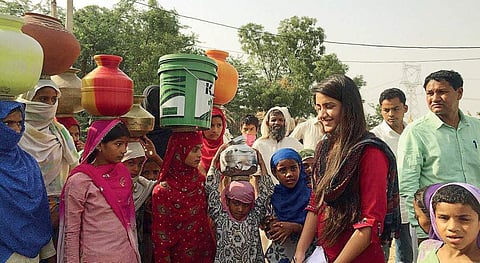

They’re teenagers, but that didn’t stop Sia and Taahira from planning and executing a herculean project that provides an underdeveloped village in Haryana with access to water. Tushar Kaushik finds out what drove them to come up with this project and how they have changed lives
When Taahira Bhalla and Sia Bishnoi, of classes XI and IX respectively, decided to visit Ferozepur Meo — an underdeveloped village in the interiors of Haryana, even they couldn’t have imagined that in five months, they would be providing a lifeline to the villagers. The teenagers have emulated a story that runs parallel to Shah Rukh Khan’s unconventionally heroic act of installing electricity in Swades, by providing the villagers easy access to water, and devised a process that would purify the ground water.
The two girls, students of The Shri Ram School, Moulsari, Gurgaon, first pitched their idea, titled Project ‘Drakht’ — meaning tree in Urdu — at The Global Education and Leadership Foundation (tGELF) forum, which envisions to build a community of ethical, altruistic leaders. Their plan was to help an underdeveloped village in Haryana get easier access to water, and their parents’ knowledge of the state, helped them zero in on Ferozepur Meo, a village in the Mewat district of the state. After their idea was selected by tGELF, sometime in June this year, only Sia could make the first trip to the village. During this trip, she spoke to the locals about their issues and found that getting clean water was the primary problem they faced. She discovered that they had to walk a distance of two to three kilometres to draw water from a borewell and the purity of the water was obviously suspect. In addition, the bumpy track often led to the spillage of water and many women, being Muslim, had to do this while wearing a hijab in the searing Haryana heat.
Sia and Taahira brainstormed for solutions and began extensive research. They also made two subsequent visits to the village. Taahira says, “We figured that even if we provide them with a pump, they’ll have to constantly keep paying for it and they don’t really have that kind of money. So we looked for alternatives.
” To ease the access to water, the girls, with a lot of support from the NGO, planned to install a solar panel, pump and storage tanks adjacent to the village. They needed to improve the quality of water and for this, they hit upon the water-purifying properties of the Moringa Oleifera (drumstick) trees, which are also used for the same purpose in many parts of Africa.
So with a plan in place all they needed was funding. The cost of the entire project was estimated at `7.5 lakh. To raise funds, the girls used the occasion of a parent-teacher meet in their school. Speaking about the effort, Taahira says, “We set up a stall with the help of our friends at the reception where all the parents could see it and we made it look attractive. We used posters, arranged real seeds on the table, and displayed a live model.
We presented the project and requested a minimum donation of `100 to sponsor the cost of each sapling.” Sia quips, “We used a proper thela (stall) that we got from a street worker.” The girls managed to raise a staggering `1.5 lakh through the effort.
Realising that they needed other sources of funds, they began a crowdfunding campaign on ketto.org. Over `3 lakh has been raised until now even as the campaign gathers steam. Sia and Taahira also managed to get 400 Moringa Oleifera saplings planted in the village. Sia says, “We gave the saplings to the children in the village and they planted most of it. We also distributed them among several families to be planted by their houses.” It will take a couple of years for the saplings to become trees and start purifying the ground water, but it is certainly a start.
Eventually, with a lot of support from the NGO, a solar panel, pump and a storage tank with a capacity of 15,000 litres was built on the periphery of the village itself. The system requires almost no maintenance for a year, and after that, the plan is to get the villagers themselves involved in its maintenance.
In all of this, they were mentored by Sanjeev Chaudhary, Advisor, CSR and Youth Development Projects, Farmers. The project is estimated to help about 2,200 people from 300 families.
Chaudhary says that the project was implemented after a lot of exhaustive planning. He explains that the current system, being solar-powered, doesn’t depend on electricity, which is erratic in most parts of rural India.
He adds that during the one or two months of the year when the weather might not make it possible for the sun’s light to reach the panels, a generator has been installed which works independent of the supply of electricity.
Meanwhile, the girls are still looking for more ways to raise funds so that they can get more Oleifera saplings planted. Their latest endeavour involved setting up a baking stall in a Diwali mela. The girls will soon be paying another visit to the village. Recalling her earlier visit, Sia says, “In the beginning, they (villagers) were very hesitant to talk to us.
It was a big challenge to get them to open up because they think that people just come and talk but don’t actually do anything.” The two young girls are certainly a boon to the village of Ferozepur Meo. Maybe a grand welcome awaits them when they make their next trip to the village.
Road to success:
How the villagers have benefitted: